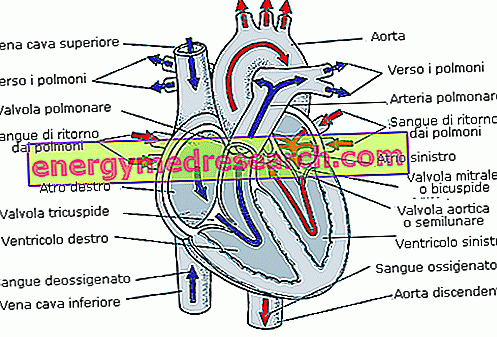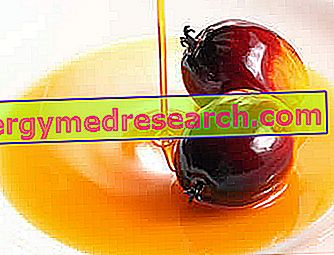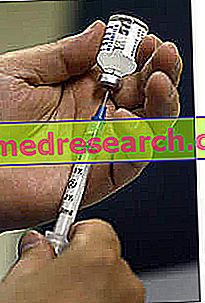The heart is a hollow organ of muscular nature, located in the thoracic cavity in a central area called the mediastinum. Its dimensions are similar to those of a man's fist; its weight, in an adult individual, is around 250-300 grams.
It has a roughly conical shape and its axis is directed forward and downward, so the right ventricle is located a little more forward than the left. The heart is covered externally by a serous membrane, called pericardium, which fixes it below the phrenic center of the diaphragm and wraps it, isolating it and protecting it from nearby organs.
Inwardly the heart is divided into four distinct cavities (or chambers), two upper and two lower, called, respectively, atriums and ventricles. On the outer face lines can be recognized, called furrows, which mark the border between atria and ventricles (coronary or atrioventricular groove), between the two atria (interatrial grooves) and between the two ventricles (longitudinal grooves).
Internally there are two septa, called interatrial septum and interventricular septum, which divide the heart into two distinct halves. Their function is to prevent any type of communication between the two atria and between the two ventricles.
Between the atria and the ventricles there are instead two valves, on the right the tricuspid and on the left the bicuspid or mitral that allow the passage of the blood in a single direction, that is from the atria to the ventricles.
Respectively from the left ventricle and from the right ventricle the aorta artery and the pulmonary artery depart, and two other valves, aortic and pulmonary, regulate the passage of blood between the ventricles and the aforementioned vessels.
In the right atrium there are three veins: the superior vena cava, the inferior vena cava and the coronary sinus, which carries blood from the coronary arteries. The pulmonary veins, which carry oxygenated blood back from the lungs, converge in the left atrium.
To know more:
Cardiac muscle or myocardium Coronary arteries Capillary veins Heart murmur Cardiac mechanics Athlete's heart Cardiovascular diseases
Coronary arteries are a system that ensures a constant supply of oxygen and nutrients to the heart muscle. This system of vessels originates from two arteries, the coronaries of the right and left that branch out in a sort of network with ever more subtle branches.
The heart can be compared to a suction and pressing pump that receives blood from the periphery and pushes it into the arteries, putting it back into circulation.
In resting conditions, during systole (contraction of the ventricles), about 70 cubic centimeters of blood are expelled from the left ventricle for a total of about 5 liters per minute. This quota can increase up to 20-30 liters during physical activity (see: Circulatory adaptations and sports). The arterial blood expelled from the left ventricle during the systole runs through the aorta and subsequent arterial branches until it reaches the capillaries of the peripheral tissues. At this level the primary function of the blood is to get nutrients and eliminate waste (see: Physiology of the capillary circulation).
The venous blood, poor in oxygen and rich in carbon dioxide, returns to the heart through the superior vena cava. When passing through the lungs, carbon dioxide is purified and enriched with oxygen again. The blood drains from the lungs through the pulmonary veins into the left atrium, where it passes into the left ventricle and from here is put back into circulation through the aorta.
The blood pathway during the cardiac cycle is schematically shown below:
LOWER CABLE VENA → UPPER CABLE VENA → RIGHT ATRIO → TRICUSPIDE → RIGHT VENTRICLE → PULMONARY VALVE → PULMONAL ARTERY → LUNGS

→ VENA POLMONARE → ATRIO SX → MITRALE OR BISCUPIDE → LEFT VENTRICLE → AORTIC-SEMILUNARE → AORTA (60-70ml)
The cardiac cycle is made possible by the alternating movements of contraction and relaxation of the myocardium or heart muscle. This sequence of events takes place independently, and is repeated for about 70-75 times per minute in rest conditions.
The stimulus for cardiac contraction originates in a point of the right atrium, called the sinoatrial node. From here, electrical stimuli spread to all cardiac regions through a capillary system of conduction. The propagation of the impulse proceeds through distinct stages: the sinoatrial node originates the stimulus that excites the atrial muscles causing their contraction. The electrical impulse then reaches the atrioventricular node and from here it propagates until it reaches the bundle of His, from which the contraction impulse of the ventricles starts.
Senaatrial node → atria contraction → atrioventricular node → bundle of His → contraction ventricles
The heart is therefore able to independently generate the stimuli for its contraction. However, it requires special external controls (sympathetic and parasympathetic nervous system) to vary contractile stimuli based on metabolic demands.



